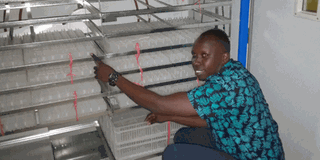Poultry hatcher gives you 1,000 chicks after 21 days

Opio explains how the device works. PHOTO by roland d nasasira
What you need to know:
A poultry hatcher does not consume as much power as an industrial machine. It uses single phase power where you fix its adapter into an electric socket, writes Roland D. Nasasira
From a distance, the microcomputer full auto hatcher looks more of a long rectangular box similar to a wardrobe in shape. When you get closer and open its two doors, is when you understand that it is capable of giving you more than enough chicks especially if you are a large scale poultry farmer.
According to Douglas Opio, the sales manager at China North Machine, the device is a two in one machine. It is built with an incubating area and a hatchery.
The incubating area that is divided into shelves or deckers is at the top while the hatchery is at the bottom level of the machine. The hatchery also has a long rectangular stainless steel bowl or trough purposely for humidity control. The bowl has to have water as a source of oxygen for chicks to breath. The machine comes with an internally-built coil that serves as the source of heat while the fan, which is positioned in front of the coil, keeps blowing the heat to circulate within and throughout the hatcher.
Temperature regulation during hatching and incubating is controlled by buttons that are positioned at the upper outer part of the machine.
The machine also comes with a hand-held torch that helps you check on the egg status without the need of opening its doors.
Operation process
According to Opio, the incubating area accommodates 3160 eggs. When loading, you have to divide the eggs put in trays by three for better day’s calculations, just like a chicken takes 21 days to hatch eggs to have accurate results. The trays are designed to fit well in the hatchery without eggs falling off.
“In the first week, you load 1,000 eggs in a tray in the first shelf. After the first week, you shift the eggs in the first shelf below to shelf two and load fresh eggs in shelf one. After the second week, you shift the very first eggs from shelf two to three and transfer those in the first shelf to the second shelf and load fresh eggs for week three,” Opio advises.
“The first top shelf is meant for fresh eggs. By the time the eggs reach the third shelf in week three, you do not need to wait for 21 days. 19 days are enough to transfer them to the hatchery. You have to have ready market for the chicks because the hatcher is a high or large scale production machine,” he adds.
Turning the eggs
The egg hatcher comes with an internal chain that is connected to the trays to help in turning eggs, just like the chicken uses its wings to turn eggs when it’s sitting on them at the hatching stage.
In this case, the wing of the machine is the chain. The more it turns, the more it turns the eggs. The chain turns the eggs 40-50 times in a minute (revolutions per minute).
What you have to master is that the incubating stage has to have a different temperature settings compared to the hatching stage. As a multi-purpose machine, the eggs for ducks, turkeys and chicken all incubate at different temperature settings as well.
You therefore have to be careful when setting the temperatures. From the incubator, the eggs are transferred to the hatchery that has different hatching tray designs.
Costs
At China North Machine and other agricultural tools dealerships, the hatcher costs Shs9m.
This comes with training on how it is operated.




